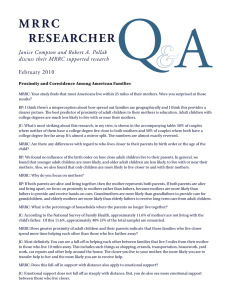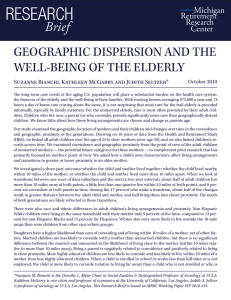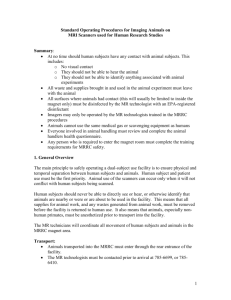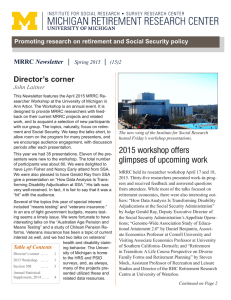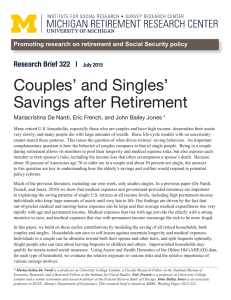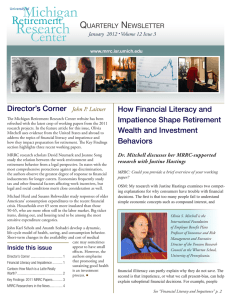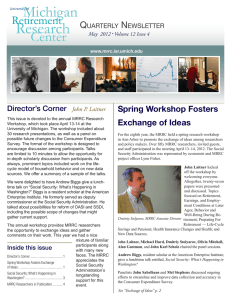Research nn Mic Michig
advertisement
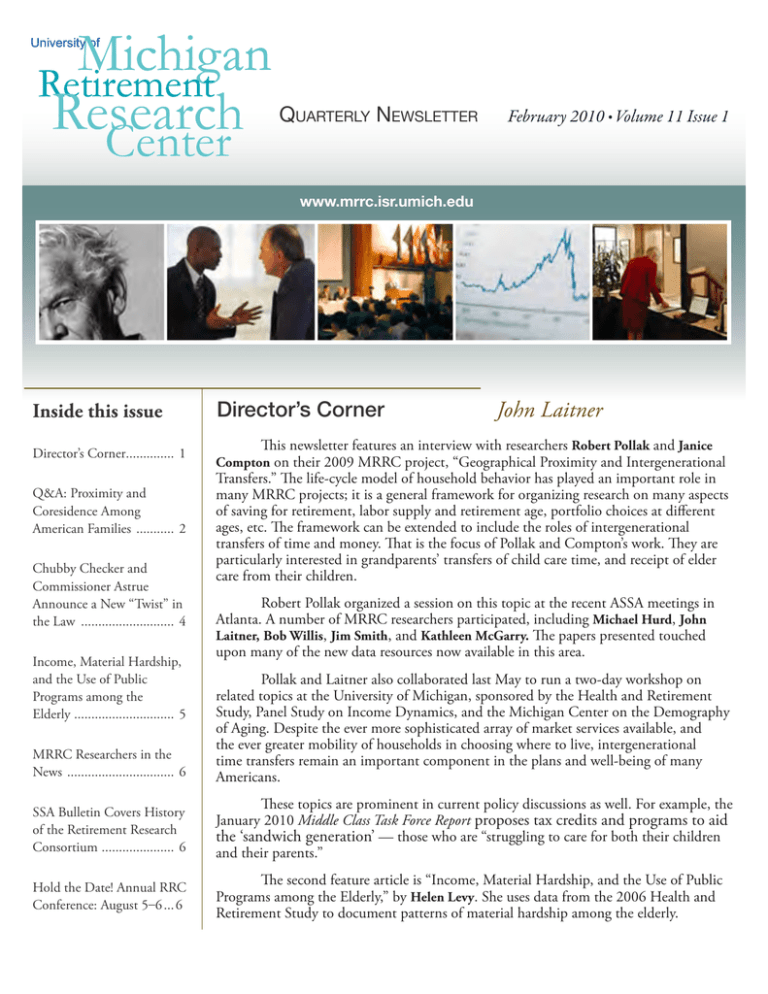
Mic Michig higa a n Retirement Research University of University of Center Quarterly Newsletter February 2010 • Volume 11 Issue 1 www.mrrc.isr.umich.edu Inside this issue Director’s Corner Director’s Corner.............. 1 Q&A: Proximity and Coresidence Among American Families ........... 2 Chubby Checker and Commissioner Astrue Announce a New “Twist” in the Law ........................... 4 Income, Material Hardship, and the Use of Public Programs among the Elderly ............................. 5 MRRC Researchers in the News ............................... 6 SSA Bulletin Covers History of the Retirement Research Consortium ..................... 6 Hold the Date! Annual RRC Conference: August 5–6 ... 6 John Laitner Q& A Proximity and Coresidence Among American Families The University of Michigan Retirement Research Center interviewed researchers Robert Pollak and Janice Compton to discuss the findings from their 2009 Working Paper, titled “Proximity and Coresidence of Adult Children and their Parents: Description and Correlates.”1 MRRC: Your study finds that most Americans live within 25 miles of their mothers. Were you surprised at those results? RP: I think there’s a misperception about how spread out families are geographically and I think this provides a clearer picture. The best predictor of proximity of adult children to their mothers is education. Adult children with college degrees are much less likely to live with or near their mothers. JC: What’s most striking about this research, in my view, is shown in the accompanying table: 50% of couples where neither of them have a college degree live close to both mothers and 50% of couples where both have a college degree live far away. It’s almost a mirror split. The numbers are almost exactly reversed. MRRC: Are there any differences with regard to who lives closer to their parents by birth order or the age of the child? RP: We found no influence of the birth order on how close adult children live to their parents. In general, we found that younger adult children are more likely, and older adult children are less likely, to live with or near their mothers. Also, we also found that only children are more likely to live closer to and with their mothers. Robert A. Pollak is the Hernreich Distinguished Professor of Economics in Arts & Sciences and the John M. Olin School of Business at Washington University in St. Louis. He specializes primarily in economics and demography. Pollak also codirects the MacArthur Network on the Family and the Economy. Janice Compton is assistant professor of economics at the University of Manitoba. She has a PhD from Washington University in St. Louis and her research interests include household economics, labor supply, time preference and experimental economics, and family issues of public finance. Of this 11.6%, approximately 40% (5% of the total sample) are remarried. MRRC: Why do you focus on mothers? MRRC:Does greater proximity of adult children and their parents indicate that those families who live closer spend more time helping each other than those who live farther away? RP: If both parents are alive and living together, then the mother represents both parents. If both parents are alive and living apart, we focus on proximity to mothers rather than fathers, because mothers are more likely than fathers to provide and receive handson care. Grandmothers are more likely than grandfathers to provide care for grandchildren, and elderly mothers are more likely than elderly fathers to receive long-term care from adult children. JC: Most definitely. You can see a fall-off in helping each other between families that live 5 miles from their mother to those who live 10 miles away. This includes such things as shopping, errands, transportation, housework, yard work, car repairs and other help around the house. The closer you live to your mother, the more likely you are to transfer help to her and the more likely you are to receive help. MRRC: What is the percentage of households where the parents no longer live together? MRRC: Does this fall-off in support with distance also apply to emotional support? JC: According to the National Survey of Family Health, approximately 11.6% of mothers are not living with the child’s father. JC: Emotional support does not fall off as steeply with distance. But, you do also see more emotional support between those who live closer. MRRC Working Paper 2009-215 was supported by a grant from the Social Security Administration through the University of Michigan Retirement Research Center. 1 2 MRRC Newsletter February 2010 RP: The most significant activities in time transfers are child care, on the one hand, and care of the disabled elderly on the other, Couples near Mother by Education Low-Power Couples: No college degree Part-Power: She has college degree Part-Power: He has college degree Power Couples: Both have college degree All Neither mother 18.9 25.5 35.8 49.4 29.3 Her Mother 17.4 23.2 13.6 15.9 16.9 His Mother 13.9 16.4 15.3 16.3 14.9 Both Mothers 49.9 34.8 35.3 18.4 38.9 1992-1994 NSFH Data* Lives within 30 miles of * NSFH Second Wave. Sample includes all couples in which both spouses are over 25 years of age and both mothers are alive and living in the U.S. which is what you would expect. And that kind of hands-on care depends on proximity or coresidence. Families that are more spread out geographically are also more likely to have more education, more income, more resources, and in that sense, almost certainly more access to market substitutes for family provided care. Americans live closer to their families than academics might have imagined, looking around at themselves and their colleagues. The explanation for that is that academics are atypical because they have a tremendous amount of education and that’s correlated with proximity in a negative way. Higher education levels mean that you tend to live farther away from your family. MRRC: Your paper states that couples who have more education are less likely to have mothers who live close to each other. Could you say a little bit more about that? JC: If you go to college, you’re more likely to marry someone who’s not from your hometown and not from your state. Power couples – where both people have a college degree – are less likely to have been born in the same state than couples with less education. It’s a different decision altogether for couples whose mothers are from different states about caring for their family and whom to live near. RP:Mothers may be a proxy for networks of other family members and friends. You shouldn’t be misled into thinking that it’s always mothers who are the only factor driving this. The location of mothers is going to be correlated with uncles, aunts, cousins, and with friends, to the extent that we’re picking up where people went to high school. So there areother kinds of networks involved. MRRC: How close do single people tend live to their mothers? RP: Adult children over 25 who are single live closer to their parents than married couples. The median distance is 15 miles for singles and between 20 and 30 miles for married couples depending on the characteristics of the couple. MRRC: If adult children are living with their mother or parents, does that usually mean that the elderly are disabled? JC: Looking at it from the point of view of the adult child, if the adult woman is married, then she might be more likely to live with her mother if her mother is old, widowed, and in need of care. But it’s a very small percentage who actually live with and take care of their mother. Gender affects coresidence differently by marital status. Single men are more likely to live with their mothers compared to single women, while married men are less likely to live with their mothers compared to married women. When these groups are separated, we find that single men are less likely to live with mothers who are in need of care, while married women are more likely to live with mothers who need care. We don’t get into the connection between care and coresidence directly in this paper. However, the evidence shows that elder care isn’t coming through coresidence as much as it used to. MRRC: One might think that American families are not very cohesive since they don’t live together as much as they did in the past, but the proximity data tells a different story. JC: Now remember that we’re looking at it from the viewpoint of the adult children. So if most adult children live within 25 miles of their mother, from the standpoint of the elderly mother, the chances that she has at least one child nearby are higher. See “Q&A” p. 4 MRRC Newsletter February 2010 3 Q&A, continued MRRC: Are single adult men actually living in their parents’ homes? RP: What’s striking about the data is how little coresidence there is of married couples with either his mother or her mother. However, almost 20% of single men coreside with mom. If you exclude coresidence, median distance of single men to their mother’s home is 15 miles. It would be interesting to know how many of the single men have never left home. Which puts a different twist on the question of who’s taking care of whom. MRRC: When adult children take care of their elderly parents, whose house are they living in? JC: If you’re living with your child and you’re not the head of the household, then you might well be disabled. Your children live with you when you’re healthy, but you live with your children when you’re not healthy. Again, these are very small percentages. RP: The dataset that can address that question is the Health and Retirement Study. And that study shows that, predominantly, when there is coresidence, the adult children own the house rather than the disabled elderly parent. MRRC: You also found that compared with whites, Hispanics are no more likely to live in close proximity to their mothers, but twice as likely to live with their mothers. And Blacks are more likely than whites to live near their mothers and more likely to live with their mothers. Why do you think this is so? JC: There are certainly cultural issues surrounding coresidence and family proximity that we do not comment on in the paper. For both Hispanics and blacks, it is likely that neighborhood effects may be stronger than for whites, due to the existence of ethnic enclaves. These groups may also have stronger cultural norms towards coresidence and close proximity. Finally, if a larger percentage of these groups are immigrants or first-generation Americans, then the higher coresidence and closer proximity may be reflecting an increased need of the mothers due to language barriers and their lower ability to access outside (i.e., market) child care. It would make for an interesting follow-up paper to consider the race and ethnicity differences more closely. Chubby Checker and Social Security Commissioner Astrue Announce a New “Twist” in the Law Change makes it easier to save on prescription drug costs January 8, 2010 — Michael J. Astrue, Commissioner of Social Security, and Chubby Checker, Grammy Award winner and rock and roll legend, launched a new campaign to inform millions of Americans about a new “twist” in the law that makes it easier to qualify for extra help with Medicare prescription drug costs. The extra help program currently provides assistance to more than nine million senior and disabled Americans — saving them an average of almost $4,000 a year on their Medicare prescription drug plan costs. “The changes in the Medicare law that take effect this month will allow hundreds of thousands of Americans who are struggling to pay their prescription drug costs to get extra help during these tough economic times,” said Commissioner Astrue. “I am thrilled that Chubby Checker has volunteered to help us spread this important message through a new television, radio, and Internet spot as well as pamphlets and posters.” “Listen up, America! For 50 years, people of all ages and backgrounds have danced the Twist,” Chubby Checker said. “Now it’s important everyone learn about this new twist in the law. Check it out at www.socialsecurity.gov.” To qualify for extra help, people must meet certain resource and income limits. The new Medicare law eases those requirements in two ways. First, it eliminates the cash value of life insurance from counting as a resource. Second, it eliminates the assistance people receive from others to pay for household expenses, such as food, rent, mortgage or utilities, from counting as income. There also is another important “twist” in the law. The application for extra help can now start the application process for Medicare Savings Programs — state programs that provide help with other Medicare costs. These programs help pay Medicare Part B (medical insurance) premiums. For some people, the Medicare Savings Programs also pay Medicare Part A (hospital insurance) premiums, if any, and Part A and B deductibles and co-payments. Watch a video featuring Chubby Checker (30 seconds): http://www.ssa.gov/pgm/flash/chubbychecker.htm. 4 MRRC Newsletter February 2010 Income, Material Hardship, and the Use of Public Programs among the Elderly Helen Levy Social Security has enjoyed great success at reducing poverty and promoting independence among the elderly. Indeed, the current official Census Bureau estimate of the poverty rate among the elderly is 9.7 percent, lower than for children or for working-age adults. The official poverty rate has been criticized on a number of grounds, however, some of which disproportionately affect the elderly. For example, one criticism of the official poverty measure is that it does not take into account the burden of high out-ofpocket medical spending, which is much more likely to be a problem for elderly households. Indeed, Census Bureau estimates using an alternative poverty measure proposed by the National Academy of Sciences to address many of these criticisms yield elderly poverty rates that are approximately twice the current official measure. These disputes over measurement and the widely different estimates they imply mean that the official poverty measure is an imperfect metric for evaluating the economic well-being of the elderly. An alternative approach to evaluating the economic well-being of the elderly is to analyze material hardship directly. This approach has been applied to the non-elderly population, particularly to single-mother families and former welfare recipients, but much less work has analyzed hardship among the elderly — perhaps because of their lower rates of official poverty. In this paper, I use data from the 2006 Health and Retirement Study to document patterns of material hardship among the elderly. Hardship is defined here as cutting back on food or medications because of cost; ten percent of elderly reported one or both of these hardships in 2006. I estimate multivariate models predicting hardship as a function of income and other characteristics, including health and cognition, in order to paint a fuller picture of why older individuals — including some with quite high incomes — experience hardship. I also estimate the relationship between income, hardship, and use of three means-tested transfer programs: Food Stamps, Medicaid, and Supplemental Security Income (SSI). Helen Levy is a Research Assistant Professor at the University of Michigan’s Institute for Social Research, an Adjunct Assistant Professor of Public Policy at the Gerald Ford School of Public Policy, and an Assistant Research Scientist in the School of Public Health at the University of Michigan. Levy is a labor and health economist whose research focuses on health insurance, with special attention to the causes and consequences of not having coverage. limitations on physical activity are significantly more likely to experience hardship. This result holds whether or not income is included as a control in the models and is also robust to the inclusion of individual fixed effects. These findings have important implications for public policy. First, since most of the elderly experiencing hardship are, in fact, not poor and therefore not eligible for meanstested transfer programs, increasing outreach with the goal of enrolling more eligible elderly in these programs has limited potential to reduce hardship. Similar logic suggests that while increasing benefit levels might reduce hardship among those who are already receiving benefits, the potential to reduce hardship by increasing benefits is limited since transfer program recipients make up only about one-quarter of the elderly who experience hardship. Second, the importance of poor health in predicting hardship demonstrates the inadequacy of the official poverty measure, since it does not take into account high out-ofpocket medical spending. Increased out-of pocket medical expenses may be reducing the resources available to some apparently high-income households, thus placing them at risk of hardship. One way to address this problem directly — without requiring any methodological changes in the measurement of poverty — would be for Medicaid and SSI to deduct some or all out-of-pocket medical spending from countable income in determining eligibility for elderly beneficiaries, as the Food Stamp program currently does for applicants ages 60 and older. This article is based on MRRC Working Paper 2009-208, which was supported by a grant from the Social Security Administration. I find that while hardship is more likely among poor individuals and, to some extent, among poor individuals who are already users of transfer programs, the majority of the elderly experiencing hardship are neither poor nor using any of these programs. In multivariate models, health status is a highly significant predictor of hardship; individuals in worse self-reported health or who report more MRRC Newsletter February 2010 5 MRRC Researchers in the News The online magazine SmartMoney, published by the Wall Street Journal, interviewed MRRC Director John Laitner about why the Social Security Administration was able to implement a Cost of Living Adjustment (COLA) in 2009 but not in 2010. In U.S. News & World Report: Money, MRRC researcher Alan Gustman (Dartmouth) explained the impact of the current economic crisis on Americans who are preparing to retire soon. Minnesota Public Radio spoke with MRRC researcher Olivia Mitchell (Wharton, University of Pennsylvania) about how to manage investment irrationality. MRRC researcher Nicole Maestas (RAND) spoke with MarketWatch.com about older workers who continue to work after age 62. SSA Bulletin Covers History of the Retirement Research Consortium Paul S. Davies and T. Lynn Fisher of the Social Security Administration published an article about the Retirement Research Consortium in the Social Security Bulletin, Vol. 69 No. 4: “The Retirement Research Consortium: Past, Present, and Future.” Each research center also wrote an article summarizing its history and research output: “The Research Contributions of the Center for Retirement Research at Boston College,” by Steven A. Sass; “Social Security Research at the Michigan Retirement Research Center,” by Richard V. Burkhauser, Alan L. Gustman, John Laitner, Olivia S. Mitchell, and Amanda Sonnega; and “Social Security in a Changing Environment: Findings From the Retirement Research Center at the National Bureau of Economic Research,” by David A. Wise and Richard G. Woodbury. Read the articles: Social Security Bulletin, Vol. 69, No. 4. Hold the Date! Annual RRC Conference: August 5–6 MRRC is hosting the annual RRC conference August 5–6, 2010. Check our website for registration information. Mic Michig higan an Retirement Research University of Center Michigan Retirement Research Center Institute for Social Research University of Michigan 426 Thompson Street, Room 3026 Ann Arbor, MI 48104-2321 Director: John P. Laitner Associate Directors: Daniel Silverman and Dmitriy Stolyarov Associate Director for External Relations: Ruth Shamraj Administrative Manager: Becky Bahlibi Phone: (734) 615-0422 Fax: (734) 615-2180 Email: mrrc@isr.umich.edu Web: http://www.mrrc.isr.umich.edu The Michigan Retirement Research Center is supported by a cooperative agreement with the Social Security Administration (10-M-98362-5-02). Regents of the University of Michigan Julia Donovan Darlow, Ann Arbor Laurence B. Deitch, Bingham Farms Denise Ilitch, Bingham Farms Olivia P. Maynard, Goodrich Andrea Fischer Newman, Ann Arbor Andrew C. Richner, Grosse Pointe Park S. Martin Taylor, Grosse Pointe Farms Katherine E. White, Ann Arbor Mary Sue Coleman, Ex Officio
